Blockchain: Future of e-Governance in Smart Cities
Abstract
:1. Introduction
- A systematic review of Blockchain technology with respect to Smart Cities;
- Exemplifying prominent works discussing the application of Blockchain technology in e-governance for Smart Cities;
- Detailed bibliometric analysis across five real-world application areas of e-governance
- A structured overview and description of publication patterns for the use of complimenting technologies such as AI, Cloud and IoT for the creation of Smart Cities
2. Smart Cities
- It provides security for our data;
- It can help in waste collection and can provide real-time information;
- It may also be useful in trading electricity;
- It also helps in mobility and can provide real-time data to the governments;
- It makes communication easier;
- It helps in improving city connectivity.
3. Introduction to Blockchain
3.1. Types of Blockchians
3.2. Consesus Algorithms
4. Rise of e-Governance & Smart Cities
5. Benefits of Blockchain Implementation in Smart Cities
- Easy and smart payments: Blockchain provides security when performing payments and requests are sent to the respective virtual machines while performing the payments. In addition, it continually updates the information regarding the payments and maintains a proper history;
- Identity Services: nowadays, many organizations use this technology for identification purposes. They use unique login services and authenticate personal identity using the same, which helps prevent identity theft and fraud;
- Transportation Management: provides a single link of payment for various forms of public transport, which includes ridesharing services. A person using a taxi and bus can pay through a single-mode using Blockchain technology;
- Government Services: it helps in maintaining a proper record of documents and identity information of the citizens. This technology will enable the delivery of focused and personalized government services.
6. Application Areas of Blockchain in e-Governance
6.1. Energy Trading
6.2. Smart Healthcare
6.3. e-Voting
6.4. Supply Chain
6.5. Real Estate
7. Literature Survey
7.1. Methodology
- Smart city or smart cities (SC);
- Blockchain + SC;
- Blockchain + e-governance;
- Blockchain + SC + Smart Healthcare;
- Blockchain + SC + e-voting;
- Blockchain + SC + Energy Trading;
- Blockchain + SC + Supply Chain;
- Blockchain + SC + Real Estate;
- Blockchain + SC + (IoT or Internet of Things);
- Blockchain + SC + AI;
- Blockchain + SC + Cloud Computing.
7.2. e-Gov vs. Smart Cities
7.3. Blockchain Application Areas
7.4. Allied Technologies for Blockchain
8. Discussion & Conclusions
- New age disruptive technologies such as Blockchain, IoT, AI and Cloud can be combined together to render solutions for sustainable smart cities;
- Policymakers need to educate themselves with respect to Blockchain and understand the means and methods of its applicability across various areas of e-governance;
- Existing research suggests that countries have started working towards Blockchain integration in the form of pilot studies and, in years to come it will become a living reality;
- Emergence of Blockchain will eliminate the role of any third party intermediatory thus ensuring transparency, trust and growth in the economy;
- Blockchain integration with smart cities will give rise to new business models in domains of supply chain and energy trading. Individual citizens and government agencies will largely benefit economically from such new initiates;
- Citizen participation will see a significant rise in the decision-making process, thanks to the involvement of technologies such as Blockchain, IoT and AI. Higher levels of automation can be expected in decision making and problem solving;
- Overall, Blockchain will introduce a new sense of trust, transparency and security between citizens and governments.
Author Contributions
Funding
Institutional Review Board Statement
Informed Consent Statement
Data Availability Statement
Conflicts of Interest
References
- Farouk, A.; Alahmadi, A.; Ghose, S.; Mashatan, A. Blockchain platform for industrial healthcare: Vision and future opportunities. Comput. Commun. 2020, 154, 223–235. [Google Scholar] [CrossRef]
- Feng, H.; Wang, X.; Duan, Y.; Zhang, J.; Zhang, X. Applying blockchain technology to improve agri-food traceability: A review of development methods, benefits and challenges. J. Clean. Prod. 2020, 260, 121031. [Google Scholar] [CrossRef]
- Haque, A.K.M.B.; Bhushan, B.; Dhiman, G. Conceptualizing smart city applications: Requirements, architecture, security issues, and emerging trends. Expert Syst. 2021. [Google Scholar] [CrossRef]
- Bhushan, B.; Sinha, P.; Sagayam, K.M.; Andrew, J. Untangling blockchain technology: A survey on state of the art, security threats, privacy services, applications and future research directions. Comput. Electr. Eng. 2021, 90, 106897. [Google Scholar] [CrossRef]
- Bhushan, B.; Khamparia, A.; Sagayam, K.M.; Sharma, S.K.; Ahad, M.A.; Debnath, N.C. Blockchain for smart cities: A review of architectures, integration trends and future research directions. Sustain. Cities Soc. 2020, 61, 102360. [Google Scholar] [CrossRef]
- Bhushan, B.; Sahoo, C.; Sinha, P.; Khamparia, A. Unification of Blockchain and Internet of Things (BIoT): Requirements, working model, challenges and future directions. Wirel. Netw. 2021, 27, 55–90. [Google Scholar] [CrossRef]
- Rawat, S.; Sah, A. An approach to Enhance the software and services of Health care centre. IISTE 2012, 3, 126–137. [Google Scholar]
- Sah, A.; Dumka, A.; Rawat, S. Web Technology Systems Integration Using SOA and Web Services. In Handbook of Research on Contemporary Perspectives on Web-Based Systems; IGI Global: Hershey, PA, USA, 2018; pp. 24–45. [Google Scholar]
- Dumka, A.; Sah, A. Smart ambulance traffic management system (SATMS)—A support for wearable and implantable medical devices. In Wearable and Implantable Medical Devices; Elsevier: Amsterdam, The Netherlands, 2020; pp. 215–228. [Google Scholar]
- Ali, R.; Qadri, Y.A.; Bin Zikria, Y.; Al-Turjman, F.; Kim, B.-S.; Kim, S.W. A Blockchain Model for Trustworthiness in the Internet of Things (IoT)-Based Smart-Cities. In Trends in Cloud-Based IoT; EAI/Springer Innovations in Communication and Computing; Springer: Cham, Switzerland, 2020; pp. 1–19. [Google Scholar] [CrossRef]
- Rathee, G.; Ahmad, F.; Sandhu, R.; Kerrache, C.A.; Azad, M.A. On the design and implementation of a secure blockchain-based hybrid framework for Industrial Internet-of-Things. Inf. Process. Manag. 2021, 58, 102526. [Google Scholar] [CrossRef]
- Babbar, H.; Rani, S.; Singh, A.; Abd-Elnaby, M.; Choi, B.J. Cloud Based Smart City Services for Industrial Internet of Things in Software-Defined Networking. Sustainability 2021, 13, 8910. [Google Scholar] [CrossRef]
- Khattak, H.A.; Tehreem, K.; Almogren, A.; Ameer, Z.; Din, I.U.; Adnan, M. Dynamic pricing in industrial internet of things: Blockchain application for energy management in smart cities. J. Inf. Secur. Appl. 2020, 55, 102615. [Google Scholar] [CrossRef]
- Ashena, E. Evaluating a Blockchain-based Method for Industrial IoT Data Confidentiality: Proof of Concept. In Proceedings of the 2021 7th International Conference on Web Research (ICWR), Teheran, Iran, 19–20 May 2021; IEEE: Manhattan, NY, USA, 2021; pp. 260–266. [Google Scholar]
- Perez Dominguez, L.A.; Contreas-Masse, R.; Ochoa-Zezzatti, A.; Garcia, V.; Elizondo-Cortes, M. Implementing a novel use of multicriteria decision analysis to select IIoT platforms for smart manufacturing. Symmetry 2020, 12, 368. [Google Scholar]
- Umair, M.; Cheema, M.; Cheema, O.; Li, H.; Lu, H. Impact of COVID-19 on IoT Adoption in Healthcare, Smart Homes, Smart Buildings, Smart Cities, Transportation and Industrial IoT. Sensors 2021, 21, 3838. [Google Scholar] [CrossRef]
- Ammi, M.; Alarabi, S.; Benkhelifa, E. Customized blockchain-based architecture for secure smart home for lightweight IoT. Inf. Process. Manag. 2021, 58, 102482. [Google Scholar] [CrossRef]
- Yang, Q.; Wang, H. Privacy-Preserving Transactive Energy Management for IoT-aided Smart Homes via Blockchain. IEEE Internet Things J. 2021, 8, 11463–11475. [Google Scholar] [CrossRef]
- Rajashree, S.; Sukumar, R. CBC (Cipher Block Chaining)-Based Authenticated Encryption for Securing Sensor Data in Smart Home. In Smart IoT for Research and Industry; Springer: Cham, Switzerland, 2022; pp. 189–204. [Google Scholar]
- Kolahan, A.; Maadi, S.R.; Teymouri, Z.; Schenone, C. Blockchain-based solution for energy demand-side management of residential buildings. Sustain. Cities Soc. 2021, 75, 103316. [Google Scholar] [CrossRef]
- Vamsi, T.M.N.; Chakravarthi, G.K.; Lanka, P.; Divakar, B. An IoT Based Smart Garbage Monitoring and Disposal Support System. In Proceedings of the 2021 5th International Conference on Computing Methodologies and Communication (ICCMC), Erode, India, 8–10 April 2021; IEEE: Manhattan, NY, USA, 2021; pp. 438–442. [Google Scholar]
- Baldo, D.; Mecocci, A.; Parrino, S.; Peruzzi, G.; Pozzebon, A. A Multi-Layer LoRaWAN Infrastructure for Smart Waste Management. Sensors 2021, 21, 2600. [Google Scholar] [CrossRef]
- Ramson, S.J.; Moni, D.J.; Vishnu, S.; Anagnostopoulos, T.; Kirubaraj, A.A.; Fan, X. An IoT-based bin level monitoring system for solid waste management. J. Mater. Cycles Waste Manag. 2021, 23, 516–525. [Google Scholar] [CrossRef]
- Gopikumar, S.; Raja, S.; Robinson, Y.H.; Shanmuganathan, V.; Chang, H.; Rho, S. A method of landfill leachate management using internet of things for sustainable smart city development. Sustain. Cities Soc. 2021, 66, 102521. [Google Scholar] [CrossRef]
- Dzhuguryan, T.; Deja, A. Sustainable Waste Management for a City Multifloor Manufacturing Cluster: A Framework for Designing a Smart Supply Chain. Sustainability 2021, 13, 1540. [Google Scholar] [CrossRef]
- Gupta, Y.S.; Mukherjee, S.; Dutta, R.; Bhattacharya, S. A blockchain-based approach using smart contracts to develop a smart waste management system. Int. J. Environ. Sci. Technol. 2021, 1–24. [Google Scholar] [CrossRef]
- Li, Z.; Alazab, M.; Garg, S.; Hossain, M.S. PriParkRec: Privacy-Preserving Decentralized Parking Recommendation Service. IEEE Trans. Veh. Technol. 2021, 70, 4037–4050. [Google Scholar] [CrossRef]
- Badr, M.M.; Al Amiri, W.; Fouda, M.M.; Mahmoud, M.M.E.A.; Aljohani, A.J.; Alasmary, W. Smart Parking System With Privacy Preservation and Reputation Management Using Blockchain. IEEE Access 2020, 8, 150823–150843. [Google Scholar] [CrossRef]
- Wang, S.M.; Cheng, W.M. Solve the Problem of Urban Parking Through Carpooling System and Blockchain Advertising. In International Conference on Human-Computer Interaction, Washington, DC, USA, 24–29 July 2021; Springer: Cham, Switzerland, 2021; pp. 144–155. [Google Scholar]
- Kim, M.; Kim, Y. Multi-Blockchain Structure for a Crowdsensing-Based Smart Parking System. Futur. Internet 2020, 12, 90. [Google Scholar] [CrossRef]
- Zhang, C.; Zhu, L.; Xu, C.; Sharif, K.; Wu, H.; Westermann, H. BSFP: Blockchain-Enabled Smart Parking With Fairness, Reliability and Privacy Protection. IEEE Trans. Veh. Technol. 2020, 69, 6578–6591. [Google Scholar] [CrossRef]
- Gehlot, A.; Alshamrani, S.; Singh, R.; Rashid, M.; Akram, S.; AlGhamdi, A.; Albogamy, F. Internet of Things and Long-Range-Based Smart Lampposts for Illuminating Smart Cities. Sustainability 2021, 13, 6398. [Google Scholar] [CrossRef]
- Xu, W.; Kim, J.Y.; Huang, W.; Kanhere, S.; Jha, S.; Hu, W. EMIoT: A LoRa-enabled Smart Building Solution Based on Emergency Lights. In Proceedings of the 7th ACM International Conference on Systems for Energy-Efficient Buildings, Cities, and Transportation , Virtual Event, Japan, 18–20 November 2020; pp. 330–331. [Google Scholar]
- Mishra, S.; Kumar, S. Smart Voltage Monitoring: Centralised and Blockchain-based Decentralised Approach. In Proceedings of the 2020 IEEE International Conference on Internet of Things and Intelligence System (IoTaIS), Bali, Indonesia, 27–28 January 2021; IEEE: Manhattan, NY, USA, 2021; pp. 49–55. [Google Scholar]
- Soomro, S.; Miraz, M.H.; Prasanth, A.; Abdullah, M. Artificial Intelligence Enabled IoT: Traffic Congestion Reduction in Smart Cities. In Proceedings of the IET Conference, Manama, Bahrain, 22–23 April 2018; pp. 6–13. [Google Scholar] [CrossRef]
- Cugurullo, F. Urban Artificial Intelligence: From Automation to Autonomy in the Smart City. Front. Sustain. Cities 2020, 2, 38. [Google Scholar] [CrossRef]
- Lv, Z.; Lou, R.; Singh, A.K. AI Empowered Communication Systems for Intelligent Transportation Systems. IEEE Trans. Intell. Transp. Syst. 2021, 22, 4579–4587. [Google Scholar] [CrossRef]
- Thanh, T.T.M.; Ly, H.B.; Pham, B.T. A Possibility of AI Application on Mode-choice Prediction of Transport Users in Hanoi. In CIGOS 2019, Innovation for Sustainable Infrastructure. Lecture Notes in Civil Engineering; Ha-Minh, C., Dao, D., Benboudjema, F., Derrible, S., Huynh, D., Tang, A., Eds.; Springer: Singapore; Volume 54. [CrossRef]
- Hlaing, S.S.; Tin, M.M.; Khin, M.M.; Wai, P.P.; Sinha, G.R. Big Traffic Data Analytics For Smart Urban Intel-ligent Traffic System Using Machine Learning Techniques. In Proceedings of the 2020 IEEE 9th Global Conference on Consumer Electronics (GCCE), Kyoto, Japan, 12–15 October 2020; pp. 299–300. [Google Scholar]
- Khanna, A.; Goyal, R.; Verma, M.; Joshi, D. Intelligent Traffic Management System for Smart Cities. In Proceedings of the International Conference on Futuristic Trends in Network and Communication Technologies, Chandigarh, India, 22–23 November 2019; Springer: Singapore, 2019; pp. 152–164. [Google Scholar]
- Shaikh, R.A.J.; Naidu, H.; Kokate, P.A. Next-generation wsn for environmental monitoring employing big data ana-lytics, machine learning and artificial intelligence. In Evolutionary Computing and Mobile Sustainable Networks; Springer: Singapore, 2021; pp. 181–196. [Google Scholar]
- Sunny, A.I.; Zhao, A.; Li, L.; Kanteh Sakiliba, S. Low-Cost IoT-Based Sensor System: A Case Study on Harsh Envi-ronmental Monitoring. Sensors 2021, 21, 214. [Google Scholar] [CrossRef]
- Ye, Z.; Yang, J.; Zhong, N.; Tu, X.; Jia, J.; Wang, J. Tackling environmental challenges in pollution controls using artificial intelligence: A review. Sci. Total. Environ. 2020, 699, 134279. [Google Scholar] [CrossRef]
- Ighalo, J.O.; Adeniyi, A.G.; Marques, G. Artificial intelligence for surface water quality monitoring and assessment: A systematic literature analysis. Model. Earth Syst. Environ. 2021, 7, 669–681. [Google Scholar] [CrossRef]
- Selim, M.; Zhou, R.; Feng, W.; Quinsey, P. Estimating Energy Forecasting Uncertainty for Reliable AI Autonomous Smart Grid Design. Energies 2021, 14, 247. [Google Scholar] [CrossRef]
- Lu, T.; Chen, X.; McElroy, M.B.; Nielsen, C.P.; Wu, Q.; Ai, Q. A Reinforcement Learning-Based Decision System for Electricity Pricing Plan Selection by Smart Grid End Users. IEEE Trans. Smart Grid 2021, 12, 2176–2187. [Google Scholar] [CrossRef]
- ElHusseini, H.; Assi, C.; Moussa, B.; Attallah, R.; Ghrayeb, A. Blockchain, AI and Smart Grids: The Three Musketeers to a Decentralized EV Charging Infrastructure. IEEE Internet Things Mag. 2020, 3, 24–29. [Google Scholar] [CrossRef]
- Kumar, N.M.; Chand, A.A.; Malvoni, M.; Prasad, K.A.; Mamun, K.A.; Islam, F.; Chopra, S.S. Distributed energy resources and the application of AI, IoT, and blockchain in smart grids. Energies 2020, 13, 5739. [Google Scholar] [CrossRef]
- Singh, S.; Sharma, P.K.; Yoon, B.; Shojafar, M.; Cho, G.H.; Ra, I.-H. Convergence of blockchain and artificial intelligence in IoT network for the sustainable smart city. Sustain. Cities Soc. 2020, 63, 102364. [Google Scholar] [CrossRef]
- Şerban, A.C.; Lytras, M.D. Artificial intelligence for smart renewable energy sector in europe—Smart energy infra-structures for next generation smart cities. IEEE Access 2020, 8, 77364–77377. [Google Scholar] [CrossRef]
- Arslanian, H.; Fischer, F. The Future of Finance: The Impact of FinTech, AI, and Crypto on Financial Services; Springer: Singapore, 2019. [Google Scholar]
- Max, R.; Kriebitz, A.; Von Websky, C. Ethical Considerations About the Implications of Artificial Intelligence in Finance. In International Handbooks in Business Ethics; Humana Press: Totowa, NJ, USA, 2021; pp. 577–592. [Google Scholar]
- Mhlanga, D. Industry 4.0 in Finance: The Impact of Artificial Intelligence (AI) on Digital Financial Inclusion. Int. J. Financial Stud. 2020, 8, 45. [Google Scholar] [CrossRef]
- Königstorfer, F.; Thalmann, S. Applications of Artificial Intelligence in commercial banks—A research agenda for behavioral finance. J. Behav. Exp. Financ. 2020, 27, 100352. [Google Scholar] [CrossRef]
- Hassani, H.; Huang, X.; Silva, E. Big-Crypto: Big Data, Blockchain and Cryptocurrency. Big Data Cogn. Comput. 2018, 2, 34. [Google Scholar] [CrossRef] [Green Version]
- Vincent, D.R.; Deepa, N.; Elavarasan, D.; Srinivasan, K.; Chauhdary, S.H.; Iwendi, C. Sensors driven AI-based agri-culture recommendation model for assessing land suitability. Sensors 2019, 19, 3667. [Google Scholar] [CrossRef] [Green Version]
- Liu, S.Y. Artificial Intelligence (AI) in Agriculture. IT Prof. 2020, 22, 14–15. [Google Scholar] [CrossRef]
- Alreshidi, E. Smart Sustainable Agriculture (SSA) Solution Underpinned by Internet of Things (IoT) and Artificial Intelligence (AI). Int. J. Adv. Comput. Sci. Appl. 2019, 10. [Google Scholar] [CrossRef]
- Shadrin, D.; Menshchikov, A.; Somov, A.; Bornemann, G.; Hauslage, J.; Fedorov, M. Enabling Precision Agriculture Through Embedded Sensing With Artificial Intelligence. IEEE Trans. Instrum. Meas. 2020, 69, 4103–4113. [Google Scholar] [CrossRef]
- Sankaranarayanan, S. Applications of Artificial Intelligence for Smart Agriculture. In AI-Based Services for Smart Cities and Urban Infrastructure; Lyu, K., Hu, M., Du, J., Sugumaran, V., Eds.; IGI Global: Hershey, PA, USA, 2021; pp. 277–288. [Google Scholar] [CrossRef]
- Bhardwaj, H.; Tomar, P.; Sakalle, A.; Sharma, U. Artificial Intelligence and Its Applications in Agriculture With the Future of Smart Agriculture Techniques. In Advances in Environmental Engineering and Green Technologies; IGI Global: Hershey, PA, USA, 2021; pp. 25–39. [Google Scholar]
- Ragavi, B.; Pavithra, L.; Sandhiyadevi, P.; Mohanapriya, G.; Harikirubha, S. Smart Agriculture with AI Sensor by Using Agrobot. In Proceedings of the 2020 Fourth International Conference on Computing Methodologies and Communication (ICCMC), Erode, India, 11–13 March 2020; IEEE: Manhattan, NY, USA, 2020; pp. 1–4. [Google Scholar]
- Ciruela-Lorenzo, A.M.; Del-Aguila-Obra, A.R.; Padilla-Meléndez, A.; Plaza-Angulo, J.J. Digitalization of Agri-Cooperatives in the Smart Agriculture Context. Proposal of a Digital Diagnosis Tool. Sustainability 2020, 12, 1325. [Google Scholar] [CrossRef] [Green Version]
- Xu, L.; Li, Q.; Min, X.; Cui, L.; Xiao, Z. Collaborate Computing: Networking, Applications and Worksharing. In Proceedings of the 12th International Conference, CollaborateCom 2016, Beijing, China, 10–11 November 2016; Springer: Amsterdam, The Netherlands, 2017; pp. 490–496. [Google Scholar]
- Negi, D.; Sah, A.; Rawat, S.; Choudhury, T.; Khanna, A. Block Chain Platforms and Smart Contracts. In Blockchain Applications in IoT Ecosystem; Springer: Cham, Switzerland, 2021; pp. 65–76. [Google Scholar]
- Oliveira, T.A.; Oliver, M.; Ramalhinho, H. Challenges for Connecting Citizens and Smart Cities: ICT, E-Governance and Blockchain. Sustainability 2020, 12, 2926. [Google Scholar] [CrossRef] [Green Version]
- Wang, H.; Qin, H.; Zhao, M.; Wei, X.; Shen, H.; Susilo, W. Blockchain-based fair payment smart contract for public cloud storage auditing. Inf. Sci. 2020, 519, 348–362. [Google Scholar] [CrossRef]
- Mora, H.; Mendoza-Tello, J.C.; Varela-Guzmán, E.G.; Szymanski, J. Blockchain technologies to address smart city and society challenges. Comput. Hum. Behav. 2021, 122, 106854. [Google Scholar] [CrossRef]
- Paul, R.; Ghosh, N.; Sau, S.; Chakrabarti, A.; Mohapatra, P. Blockchain based secure smart city architecture using low resource IoTs. Comput. Networks 2021, 196, 108234. [Google Scholar] [CrossRef]
- Nguyen, D.C.; Pathirana, P.N.; Ding, M.; Seneviratne, A. Blockchain for 5G and beyond networks: A state of the art survey. J. Netw. Comput. Appl. 2020, 166, 102693. [Google Scholar] [CrossRef]
- Esmat, A.; de Vos, M.; Ghiassi-Farrokhfal, Y.; Palensky, P.; Epema, D. A novel decentralized platform for peer-to-peer energy trading market with blockchain technology. Appl. Energy 2021, 282, 116123. [Google Scholar] [CrossRef]
- Guo, J.; Ding, X.; Wu, W. A Blockchain-Enabled Ecosystem for Distributed Electricity Trading in Smart City. IEEE Internet Things J. 2020, 8, 2040–2050. [Google Scholar] [CrossRef]
- Said, D. A Decentralized Electricity Trading Framework (DETF) for Connected EVs: A Blockchain and Machine Learning for Profit Margin Optimization. IEEE Trans. Ind. Informatics 2020, 17, 6594–6602. [Google Scholar] [CrossRef]
- Swain, A.; Salkuti, S.; Swain, K. An Optimized and Decentralized Energy Provision System for Smart Cities. Energies 2021, 14, 1451. [Google Scholar] [CrossRef]
- Li, Z.; Kang, J.; Yu, R.; Ye, D.; Deng, Q.; Zhang, Y. Consortium Blockchain for Secure Energy Trading in Industrial Internet of Things. IEEE Trans. Ind. Inform. 2017, 14, 3690–3701. [Google Scholar] [CrossRef] [Green Version]
- Gai, K.; Wu, Y.; Zhu, L.; Qiu, M.; Shen, M. Privacy-Preserving Energy Trading Using Consortium Blockchain in Smart Grid. IEEE Trans. Ind. Informatics 2019, 15, 3548–3558. [Google Scholar] [CrossRef]
- Wang, S.; Taha, A.F.; Wang, J.; Kvaternik, K.; Hahn, A. Energy Crowdsourcing and Peer-to-Peer Energy Trading in Blockchain-Enabled Smart Grids. IEEE Trans. Syst. Man. Cybern. Syst. 2019, 49, 1612–1623. [Google Scholar] [CrossRef] [Green Version]
- Wang, Z.; Luo, N.; Zhou, P. GuardHealth: Blockchain empowered secure data management and Graph Convolutional Network enabled anomaly detection in smart healthcare. J. Parallel Distrib. Comput. 2020, 142, 1–12. [Google Scholar] [CrossRef]
- Hasavari, S.; Song, Y.T. A secure and scalable data source for emergency medical care using blockchain technology. In Proceedings of the IEEE 17th International Conference on Software Engineering Research, Management and Applications (SERA), Honolulu, HI, USA, 29–31 May 2019; pp. 71–75. [Google Scholar]
- Sharma, A.; Tomar, R.; Chilamkurti, N.; Kim, B.-G. Blockchain Based Smart Contracts for Internet of Medical Things in e-Healthcare. Electronics 2020, 9, 1609. [Google Scholar] [CrossRef]
- Javed, I.T.; Alharbi, F.; Bellaj, B.; Margaria, T.; Crespi, N.; Qureshi, K.N. Health-ID: A Blockchain-Based Decen-tralized Identity Management for Remote Healthcare. Healthcare 2021, 9, 712. [Google Scholar] [CrossRef]
- Celesti, A.; Ruggeri, A.; Fazio, M.; Galletta, A.; Villari, M.; Romano, A. Blockchain-Based Healthcare Workflow for Tele-Medical Laboratory in Federated Hospital IoT Clouds. Sensors 2020, 20, 2590. [Google Scholar] [CrossRef]
- Agbo, C.C.; Mahmoud, Q.H.; Eklund, J.M. Blockchain Technology in Healthcare: A Systematic Review. Healthcare 2019, 7, 56. [Google Scholar] [CrossRef] [Green Version]
- Fusco, A.; Dicuonzo, G.; Dell’Atti, V.; Tatullo, M. Blockchain in Healthcare: Insights on COVID-19. Int. J. Environ. Res. Public Health 2020, 17, 7167. [Google Scholar] [CrossRef]
- Qiu, J.; Liang, X.; Shetty, S.; Bowden, D. Towards Secure and Smart Healthcare in Smart Cities Using Blockchain. In Proceedings of the 2018 IEEE International Smart Cities Conference (ISC2), Kansas City, MO, USA, 16–19 September 2018; IEEE: Manhattan, NY, USA, 2018; pp. 1–4. [Google Scholar]
- Daramola, O.; Thebus, D. Architecture-Centric Evaluation of Blockchain-Based Smart Contract E-Voting for National Elections. Informatics 2020, 7, 16. [Google Scholar] [CrossRef]
- Bulut, R.; Kantarcı, A.; Keskin, S.; Bahtiyar, Ş. Blockchain-based electronic voting system for elections in Turkey. In Proceedings of the 4th International Conference on Computer Science and Engineering (UBMK), Samsun, Turkey, 11–15 September 2019; pp. 183–188. [Google Scholar]
- Taş, R.; Tanrıöver, Ö.Ö. A Systematic Review of Challenges and Opportunities of Blockchain for E-Voting. Symmetry 2020, 12, 1328. [Google Scholar] [CrossRef]
- Zhang, S.; Wang, L.; Xiong, H. Chaintegrity: Blockchain-enabled large-scale e-voting system with robustness and universal verifiability. Int. J. Inf. Secur. 2019, 19, 323–341. [Google Scholar] [CrossRef]
- Hanifatunnisa, R.; Rahardjo, B. Blockchain based e-voting recording system design. In Proceedings of the 2017 11th International Conference on Telecommunication Systems Services and Applications (TSSA), Lombok, Indonesia, 26–27 October 2017; IEEE: Manhattan, NY, USA, 2017; pp. 1–6. [Google Scholar]
- Hackius, N.; Petersen, M. Blockchain in logistics and supply chain: Trick or treat. In Digitalization in Supply Chain Management and Logistics: Smart and Digital Solutions for an Industry 4.0 Environment, Proceedings of the Hamburg International Conference of Logistics (HICL), Hamburg, Germany, 25–27 September 2017; Epubli: Berlin, Germany, 2017; Volume 23, pp. 3–18. [Google Scholar]
- Francisco, K.; Swanson, D. The Supply Chain Has No Clothes: Technology Adoption of Blockchain for Supply Chain Transparency. Logistics 2018, 2, 2. [Google Scholar] [CrossRef] [Green Version]
- Tian, F. An agri-food supply chain traceability system for China based on RFID & blockchain technology. In Proceedings of the 2016 13th International Conference on Service Systems and Service Management (ICSSSM), Kunming, China, 24–26 June 2016. [Google Scholar] [CrossRef]
- Saberi, S.; Kouhizadeh, M.; Sarkis, J.; Shen, L. Blockchain technology and its relationships to sustainable supply chain man-agement. Int. J. Prod. Res. 2019, 57, 2117–2135. [Google Scholar] [CrossRef] [Green Version]
- Schmidt, C.G.; Wagner, S.M. Blockchain and supply chain relations: A transaction cost theory perspective. J. Purch. Supply Manag. 2019, 25. [Google Scholar] [CrossRef]
- Duan, J.; Zhang, C.; Gong, Y.; Brown, S.; Li, Z. A Content-Analysis Based Literature Review in Blockchain Adoption within Food Supply Chain. Int. J. Environ. Res. Public Health 2020, 17, 1784. [Google Scholar] [CrossRef] [Green Version]
- Clauson, K.A.; Breeden, E.A.; Davidson, C.; Mackey, T.K. Leveraging Blockchain Technology to Enhance Supply Chain Management in Healthcare: An exploration of challenges and opportunities in the health supply chain. Blockchain Healthc. Today 2018, 1, 1–12. [Google Scholar] [CrossRef]
- Rejeb, A.; Keogh, J.G.; Treiblmaier, H. Leveraging the Internet of Things and Blockchain Technology in Supply Chain Management. Futur. Internet 2019, 11, 161. [Google Scholar] [CrossRef] [Green Version]
- Sladić, G.; Milosavljević, B.; Nikolić, S.; Sladić, D.; Radulović, A. A Blockchain Solution for Securing Real Property Transactions: A Case Study for Serbia. ISPRS Int. J. Geo-Information 2021, 10, 35. [Google Scholar] [CrossRef]
- Hoxha, V.; Sadiku, S. Study of factors influencing the decision to adopt the blockchain technology in real estate transactions in Kosovo. Prop. Manag. 2019, 37, 684–700. [Google Scholar] [CrossRef]
- Veuger, J. Trust in a viable real estate economy with disruption and blockchain. Facilities 2018, 36, 103–120. [Google Scholar] [CrossRef]
- Wouda, H.P.; Opdenakker, R. Blockchain technology in commercial real estate transactions. J. Prop. Invest. Financ 2019, 37, 570–579. [Google Scholar] [CrossRef]
- Dijkstra, M. Blockchain: Towards Disruption in the Real Estate Sector: An Exploration on the Impact of Blockchain Techno. Master’s Thesis, Delft University of Technology, Delft, The Netherlands, 2017. [Google Scholar]
- Garcia-Teruel, R.M. Legal challenges and opportunities of blockchain technology in the real estate sector. J. Prop. Plan. Environ. Law 2020, 12, 129–145. [Google Scholar] [CrossRef]
- Shuaib, M.; Alam, S.; Daud, S.M. Improving the Authenticity of Real Estate Land Transaction Data Using Blockchain-Based Security Scheme. In Proceedings of the International Conference on Advances in Cyber Security, Penang, Malaysia, 8–9 December 2020; Springer: Singapore, 2020; pp. 3–10. [Google Scholar]
- Scopus. Available online: https://www.scopus.com (accessed on 1 August 2021).


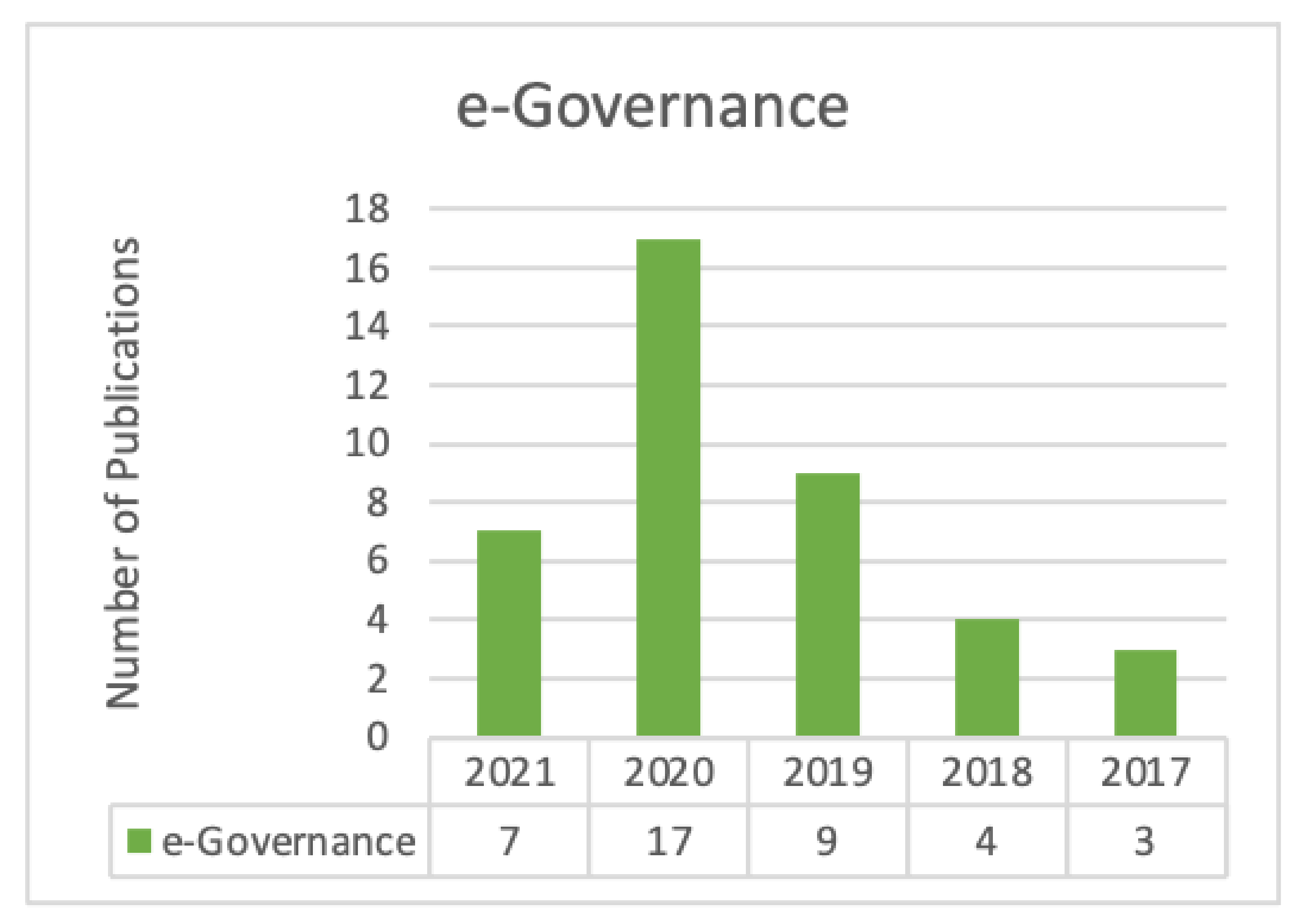
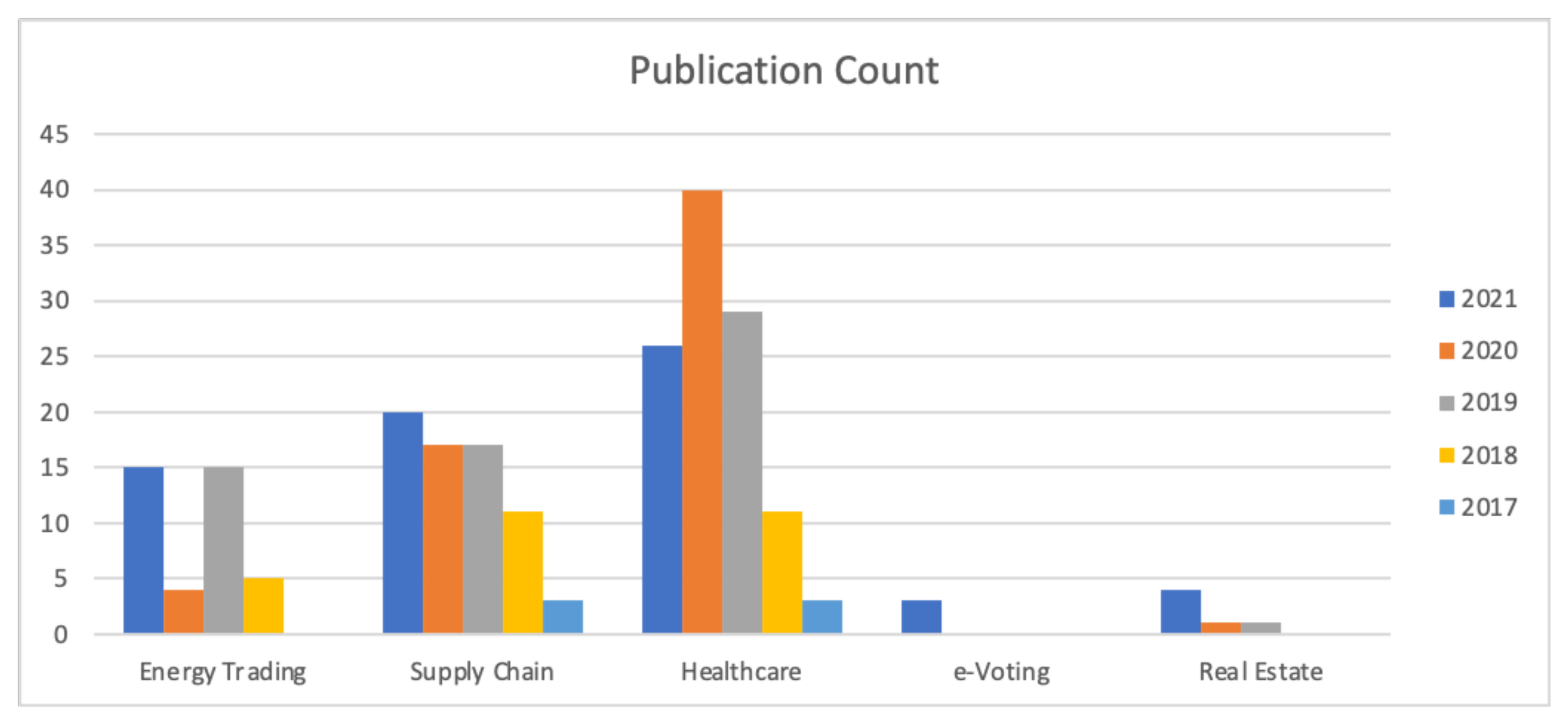
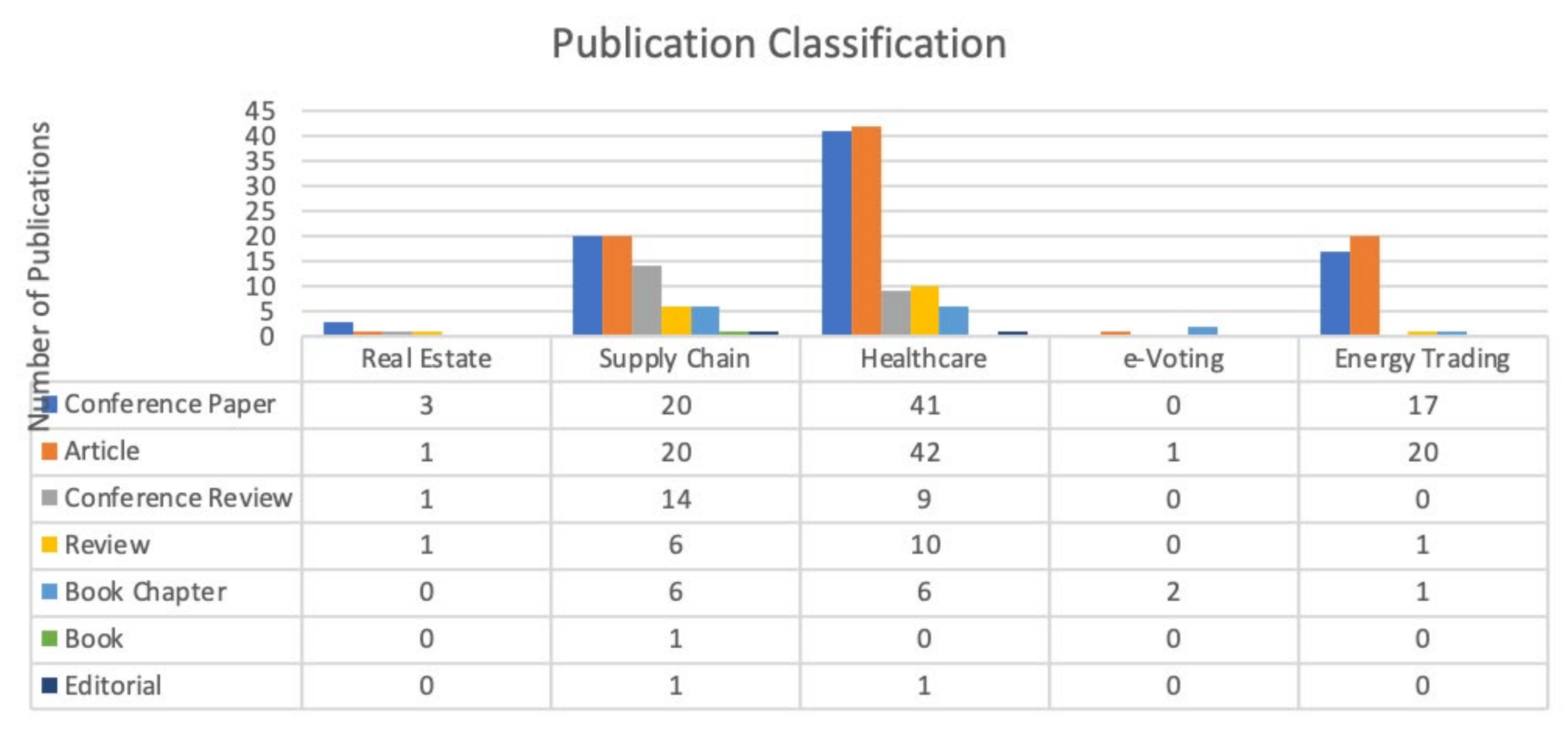

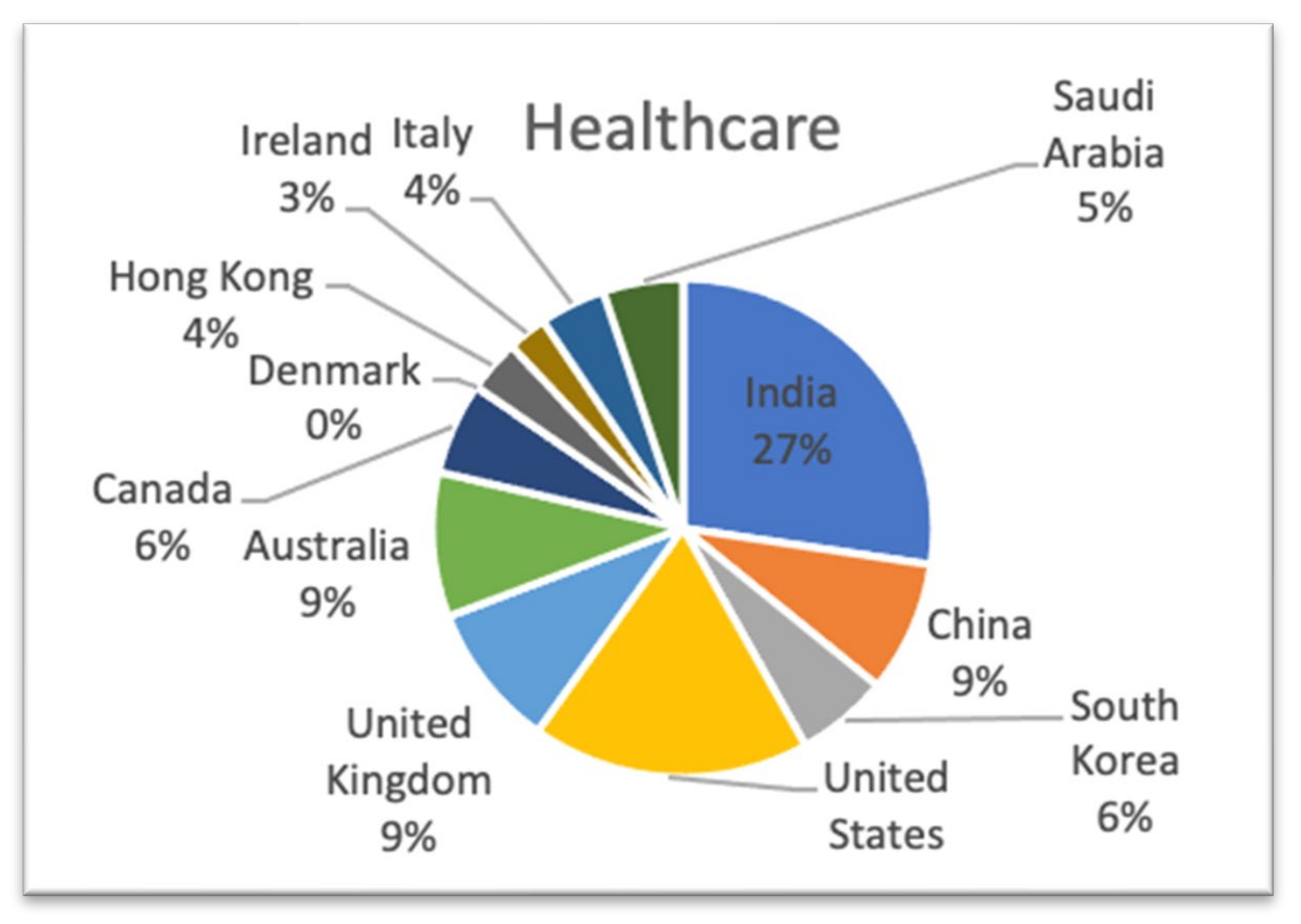
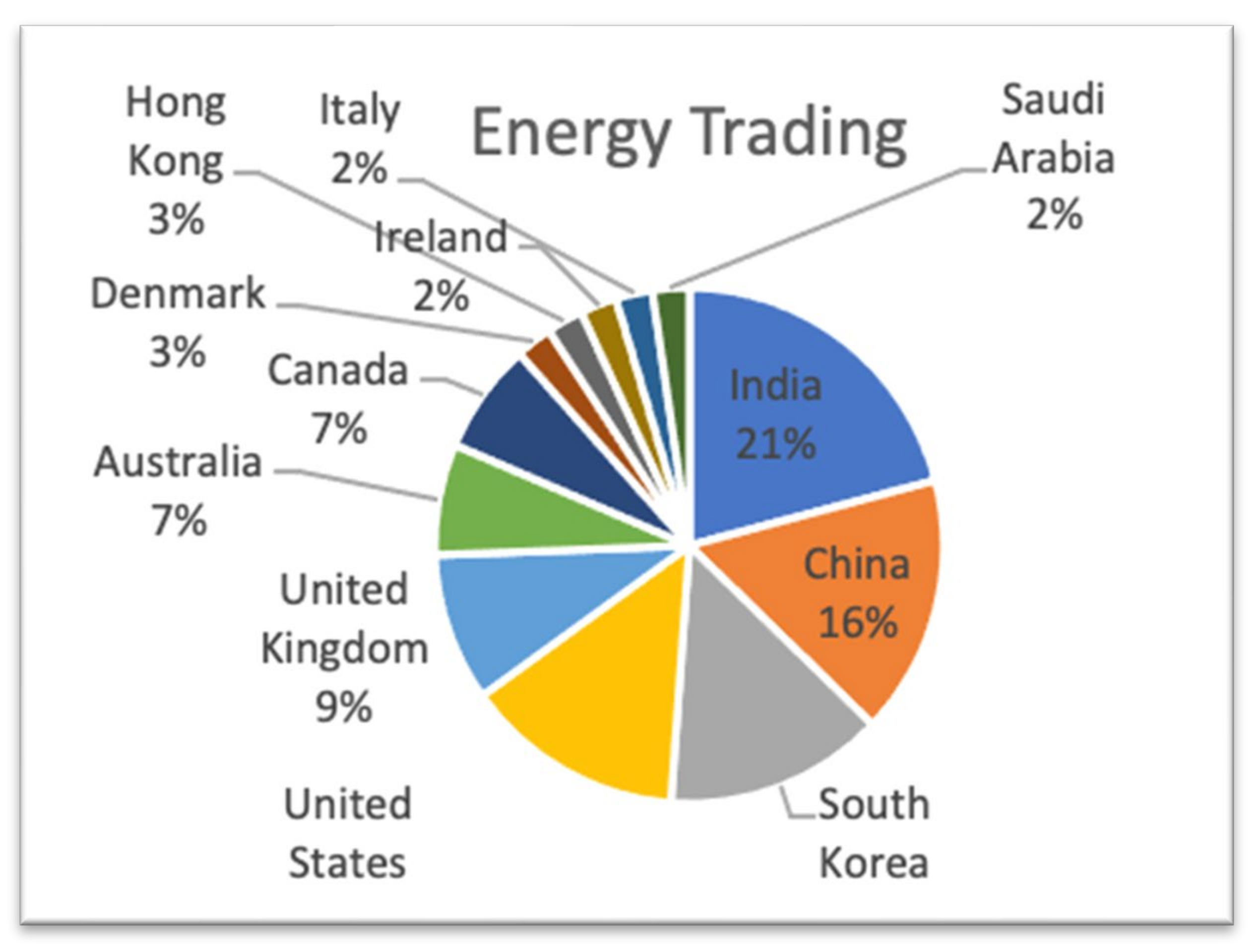
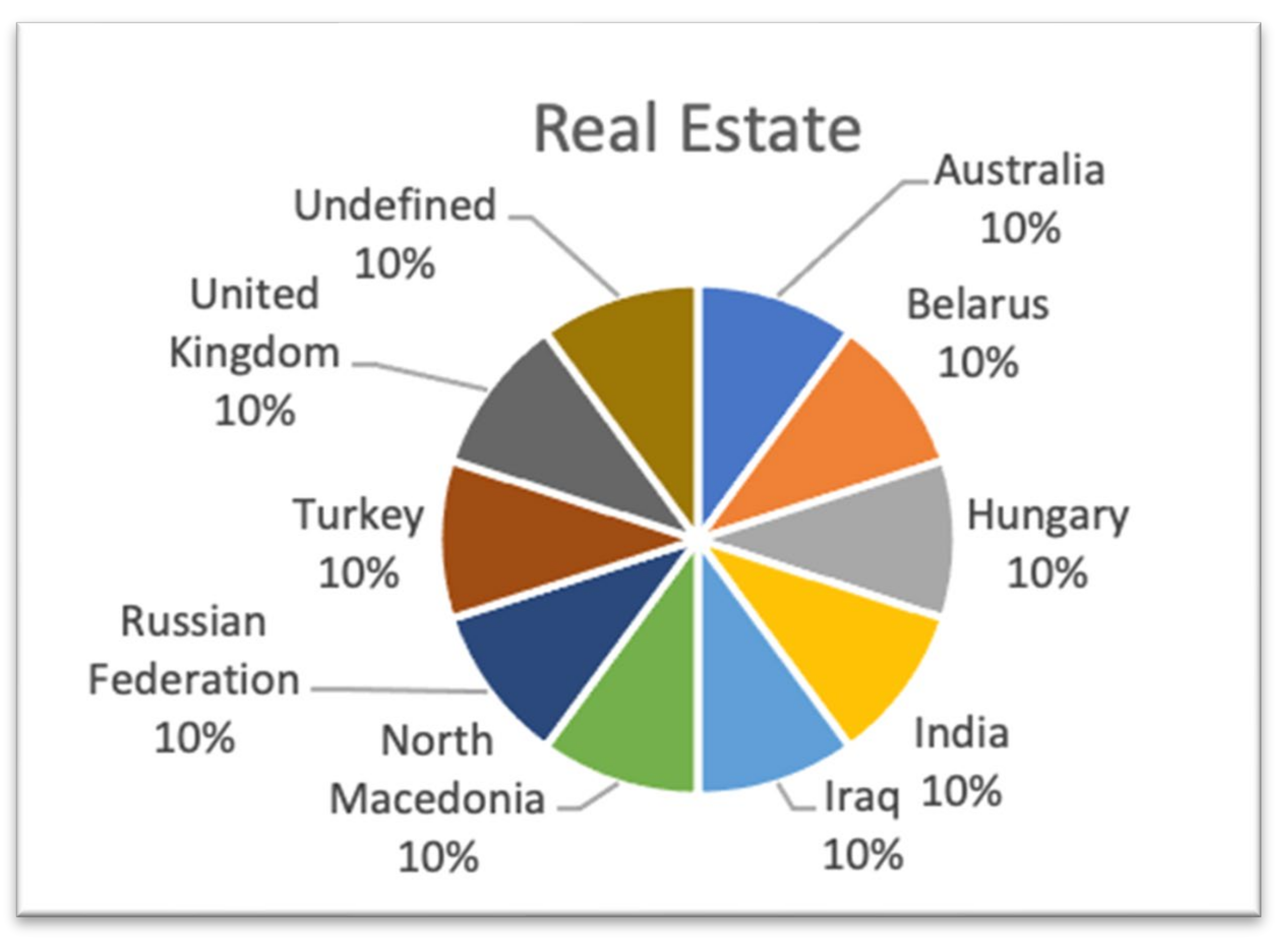
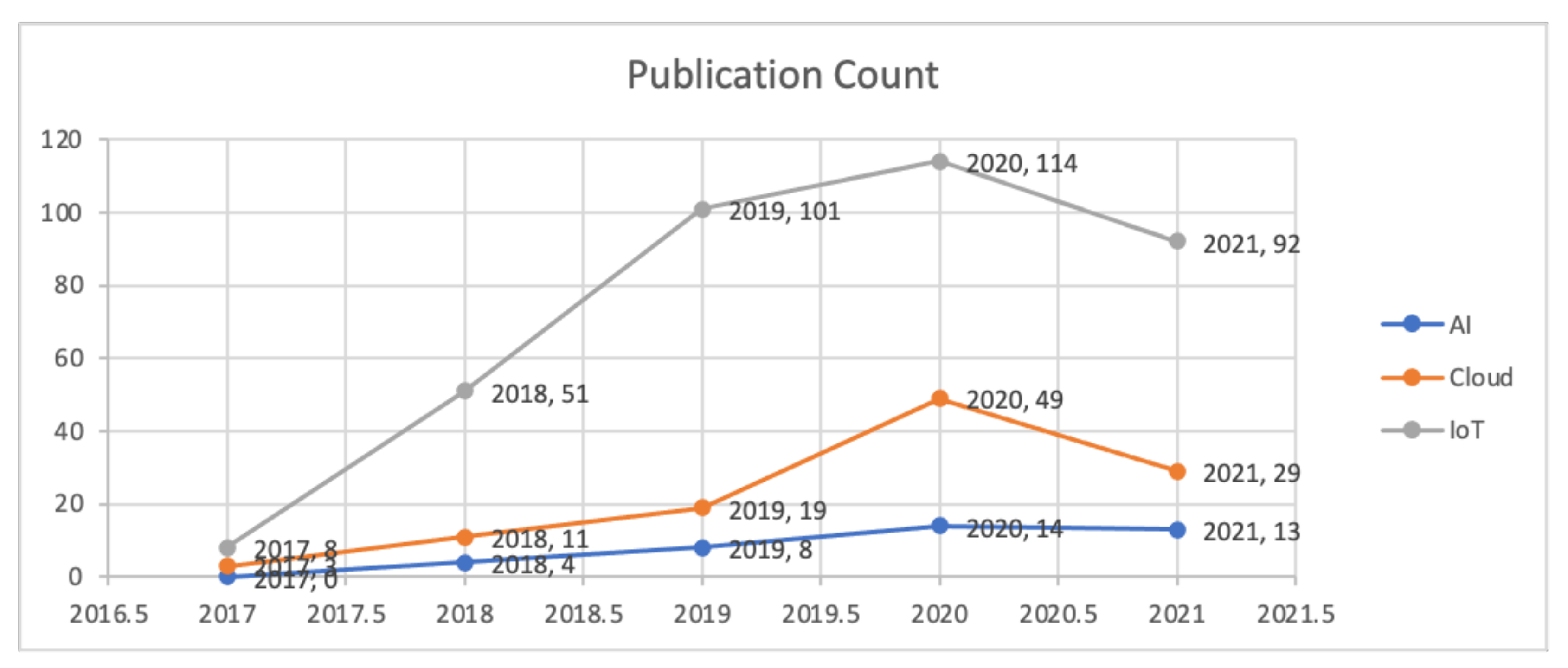


| Theme | Publications |
|---|---|
| IIoT | [10,11,12,13,14,15] |
| Smart Homes | [16,17,18,19,20] |
| Waste Management | [21,22,23,24,25,26,27] |
| Smart Parking | [28,29,30,31] |
| Smart Lighting | [32,33,34] |
Publisher’s Note: MDPI stays neutral with regard to jurisdictional claims in published maps and institutional affiliations. |
© 2021 by the authors. Licensee MDPI, Basel, Switzerland. This article is an open access article distributed under the terms and conditions of the Creative Commons Attribution (CC BY) license (https://creativecommons.org/licenses/by/4.0/).
Share and Cite
Khanna, A.; Sah, A.; Bolshev, V.; Jasinski, M.; Vinogradov, A.; Leonowicz, Z.; Jasiński, M. Blockchain: Future of e-Governance in Smart Cities. Sustainability 2021, 13, 11840. https://doi.org/10.3390/su132111840
Khanna A, Sah A, Bolshev V, Jasinski M, Vinogradov A, Leonowicz Z, Jasiński M. Blockchain: Future of e-Governance in Smart Cities. Sustainability. 2021; 13(21):11840. https://doi.org/10.3390/su132111840
Chicago/Turabian StyleKhanna, Abhirup, Anushree Sah, Vadim Bolshev, Michal Jasinski, Alexander Vinogradov, Zbigniew Leonowicz, and Marek Jasiński. 2021. "Blockchain: Future of e-Governance in Smart Cities" Sustainability 13, no. 21: 11840. https://doi.org/10.3390/su132111840
APA StyleKhanna, A., Sah, A., Bolshev, V., Jasinski, M., Vinogradov, A., Leonowicz, Z., & Jasiński, M. (2021). Blockchain: Future of e-Governance in Smart Cities. Sustainability, 13(21), 11840. https://doi.org/10.3390/su132111840









